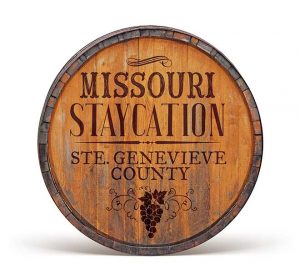
Missouri Staycation: Ste. Genevieve County
Town&Style
When was the last time you saw a sky completely full of twinkling stars? Or heard cows lowing outside your bedroom window? Or tasted grapes fresh off the vine? If, like me, the answer is ‘never,’ shame on us. Especially since a short hour’s drive can put us smack dab in the middle of some of the prettiest countryside in the U.S.
Ste. Genevieve County, just 60 miles from home, combines natural beauty with more worldly attractions (about a dozen wineries and a French Canadian settlement dating to the 1740s) to offer a weekend getaway that will make you feel like you’ve been away much longer.
Our immediate destination was Chaumette Vineyards & Winery on State Rte. WW, a popular destination among St. Louisans who have likened it to French wine country. The changing fall colors, a quiet cozy retreat and a gourmet restaurant—that was enough for an overnight escape. Anything else would just be a bonus, I thought.
Turns out we got all that and then some. Chaumette proved to be an idyllic setting, with rolling hills all around. Its ‘villas,’ attractive suites built up on wooden piers to replicate the French architectural style found in historic Ste. Genevieve nearby, had wraparound wooden porches with views of the endless rows of grapevines. Inside, we lacked for nothing, from a walk-in closet to Kaldi’s coffee.[toggle]
A hike around the property took us past the large dining room and tasting room building, set high on a hill for optimum views of the rows of Chardonel, Norton and Vignoles vines, as well as nearby cow pastures. Past that, a small chapel nestled in the woods, ready for couples who want a country wedding (of which, apparently, there are many). Intending to do the entire 3-mile loop around Chaumette, we disappeared into the woods down a gravel path, but alas, it wasn’t meant to be.
About half a mile in, we came upon an adjacent winery/brewery, Charleville, known for its Hoptimistic IPA. Turns out we zigged when we were supposed to zag, or something like that. But we were on country time, and decided to just go with the flow—Charleville, it is. On a much smaller scale than Chaumette, it was built in the same year, 2013, and we sidled up to the thick wooden bar for a Strawberry Pale Ale, $1.80 a taste, $5 for a flight of five.
Back at Chaumette, it was time for one of the weekend’s highlights: dinner at Grapevine Grill, where CIA-trained chef Rob Beasley has gotten some buzz as far away as St. Louis. A native of Louisiana, he infuses the menu with Creole-Cajun flavors; do not miss the Louisiana Shrimp, whatever you do. The flourless chocolate cake, drizzled with port and caramel sauce and plump cherries, should be on your dessert radar, too. We walked the third of a mile or so from our villa to the dining room in the dark, hoping the enormous sea of stars would light our way. Alas, it’s pitch dark out there, even with starlight, so bring a flashlight.
Day two had its own agenda, with plans for some serious hiking in the gorgeous environs, followed by exploration of historic Ste. Genevieve until the homes closed or we dropped of exhaustion, whichever came first. The hike, a 1.5-mile loop around Pickle Springs Natural Area, was breathtaking, with water features, massive boulders called hoodoos and deep stone set-backs the park map dubbed ‘canyons.’ Bring hiking boots! It is as pretty a sight as I’ve seen, but with its own Midwestern forest character of lush woods and trickling water.
Be sure to give yourself enough time for the county’s jewel in the crown: historic Ste. Genevieve. Main, Market and Merchant streets have the lion’s share of tourable properties, but homes all around town proudly display wooden plaques with the date of their founding and the name of their original family. You’ll see many in the 1700s and 1800s, several of them open for touring (not necessarily every day, however): the Louis Bolduc, Felix Valle, Jacques Guibourd, Jean-Baptiste Valle, Bequette- Ribault and Bauvais-Amoureux homes. They’re French in origin, mostly built by French Canadians who traveled south down the Mississippi to escape persecution by the British or to seek better commercial opportunities.
As a living record of Missouri’s French colonial history, the town of Ste. Genevieve is a National Historic Landmark. It originated as a French colonial settlement, and in 1803 was sold to the fledgling United States as part of the Louisiana Purchase. Most homes built during the French colonial period, including many that visitors can tour, were constructed in a distinctive style typical of French Canada called vertical-log. The wooden beams are lined up vertically, unlike the horizontally stacked logs of the typical log cabin. Interestingly, Ste. Genevieve has the largest number of these vertical log homes in the U.S. And, it has three of the remaining five poteaux-en-terre homes in the entire country, structures that are supported by wooden columns anchored directly in the dirt. Also noteworthy: it is thought that the oldest rose garden in Missouri is here, behind the Jean-Baptiste Valle House (circa 1794).
Apparently the rose cuttings came from none other than Madame Therese Chouteau, considered the matriarch of St. Louis.
[/toggle]
